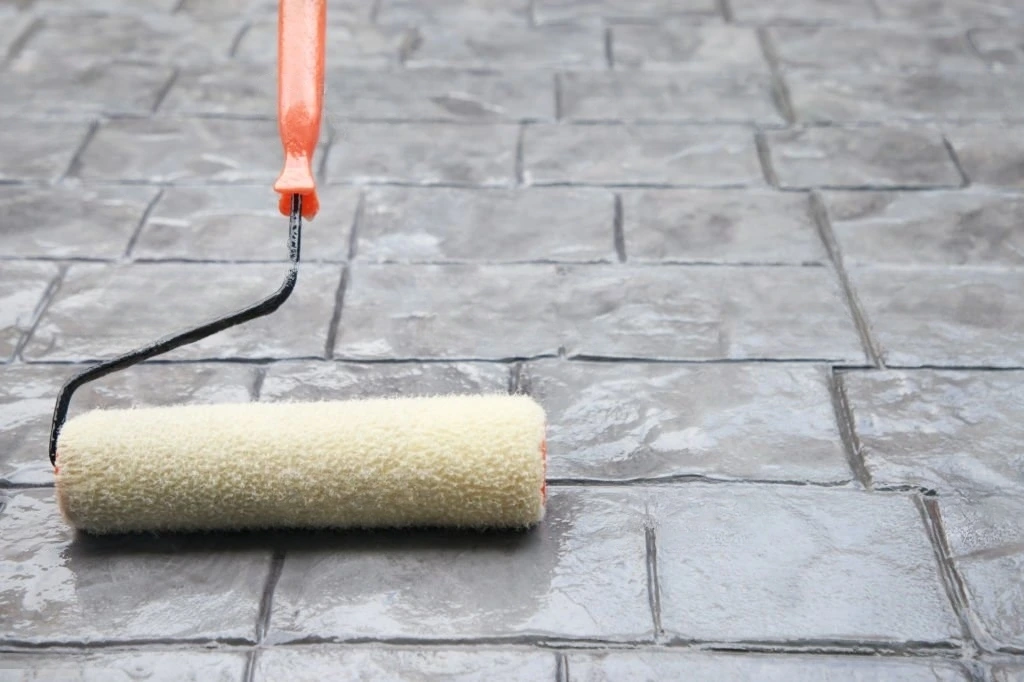Stamped concrete is popular with homeowners and business owners who want to enhance their outdoor spaces. This decorative concrete technique involves pressing a pattern or texture onto wet concrete to create a unique and attractive design. However, like any other outdoor surface, stamped concrete sidewalks require regular maintenance to keep them looking their best.
Seal coating is one of the essential maintenance tasks for stamped concrete sidewalks. Seal coating is a process of applying a protective layer of sealant to the surface of the concrete to prevent water, UV rays, and other environmental factors from damaging it. This can extend the lifespan of your stamped concrete sidewalk and keep it looking like new for years to come.
But how often should you seal stamped concrete? The answer depends on various factors, including the climate in your area, the amount of foot traffic your sidewalk receives, and the type of sealant you use. In general, it’s recommended that you reseal your stamped concrete sidewalk every two to three years, although this may vary depending on your specific situation.
A closer look at the importance of seal coating for stamped concrete sidewalks and provide tips for determining when to reseal your concrete stamped sidewalk. Whether a homeowner or a business owner, this information can help keep your outdoor space beautiful and well-maintained.
How Often Does Stamped Concrete Need To Be Sealed?
Stamped concrete is a popular choice for many homeowners looking to enhance the look of their outdoor spaces. Whether it’s a patio, driveway, or sidewalk, stamped concrete can mimic the appearance of natural materials like stone, brick, or wood, adding a unique touch of elegance and sophistication to any property.
However, like any concrete surface, stamped concrete requires regular maintenance to ensure its longevity and durability. One crucial aspect of maintaining stamped concrete is sealing. Sealing not only enhances the appearance of the concrete but also protects it from damage caused by exposure to the elements, foot traffic, and stains.
If you have a stamped concrete sidewalk or driveway, you might wonder how often it needs to be sealed to ensure it stays in top condition. The answer to this question depends on various factors, including the climate in your area, the amount of foot traffic on the surface, and the quality of the initial sealing job.
We’ll take a closer look at the frequency of sealing your concrete stamped sidewalk, the benefits of sealing, and how to tell if your stamped concrete needs to be resealed. By the end of this post, you’ll better understand how to keep your stamped concrete looking its best for years to come.
How Much For Stamped Concrete Walkway?
Stamped concrete is a popular choice among homeowners when it comes to enhancing the curb appeal of their property. This versatile material can create a wide range of decorative patterns and textures that mimic the look of natural stone, brick, or wood. Stamped concrete is not only aesthetically pleasing but also durable and long-lasting, making it an excellent investment for any homeowner.
A stamped concrete sidewalk could be the perfect solution if you’re considering installing a new walkway or upgrading your existing one. However, one of the most common questions that homeowners have is, “How much does a stamped concrete walkway cost?” The answer to this question can vary depending on several factors, such as the size of the walkway, the design complexity, and the region’s labor costs.
Dive into the cost factors involved in installing a stamped concrete sidewalk and the benefits of choosing this material over other options. We’ll also provide you with some tips on how to select the best contractor for the job and share some of the most popular stamped concrete patterns and textures to give you inspiration for your project. So, whether you want to add value to your property or enhance its appearance, read on to learn more about stamped concrete sidewalks.
What benefits Of Stamped Concrete?
Stamped concrete has been gaining popularity recently, especially in residential and commercial landscaping projects. This innovative technique uses specialized stamps to imprint patterns and textures onto freshly poured concrete. The result is a visually stunning surface that can mimic the appearance of various materials, such as stone, slate, and brick while offering the durability and strength of traditional concrete.
One of the most popular applications of stamped concrete is for sidewalks. Stamped concrete sidewalks are becoming increasingly common in urban and suburban areas due to their aesthetic appeal and durability. They offer a cost-effective alternative to traditional paving materials such as brick or stone while providing a long-lasting, low-maintenance solution.
The benefits of using stamped concrete for sidewalks go beyond just visual appeal and durability. Stamped concrete can also provide a slip-resistant surface, making it safer for pedestrians, especially in areas prone to wet or icy conditions.
We will explore the many benefits of stamped concrete, focusing on its use for sidewalks. We will discuss the advantages of stamped concrete sidewalks over traditional paving materials and explore the options available whether you are a homeowner, a business owner, or a contractor.





